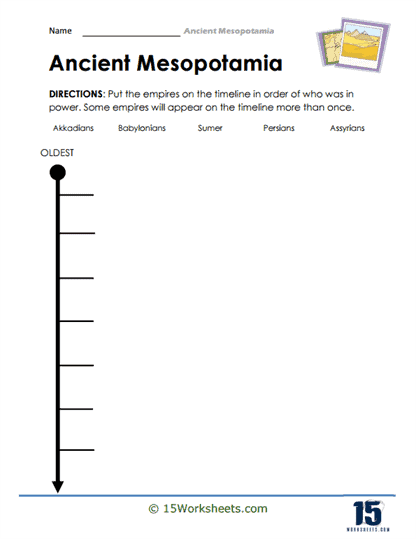Ancient Mesopotamia Timeline

Worksheet Description
You will use this worksheet to plot a timeline of the Ancient Mesopotamia civilization.
Here’s a simplified timeline of key periods and events in ancient Mesopotamian history:
Ubaid Period (c. 6500-3800 BCE) – Early settlements and the development of agriculture in the region.
Uruk Period (c. 4000-2900 BCE) – Emergence of urban centers and complex societies, with the city of Uruk as a major cultural and political hub.
Early Dynastic Period (c. 2900-2334 BCE) – Establishment of independent Sumerian city-states, development of cuneiform writing, and growth of trade networks.
Akkadian Empire (c. 2334-2154 BCE) – Unification of Mesopotamia under Sargon of Akkad, with the city of Akkad as the empire’s capital.
Third Dynasty of Ur (c. 2112-2004 BCE) – Sumerian renaissance and the reestablishment of Sumerian rule in southern Mesopotamia.
Old Assyrian Period (c. 2025-1363 BCE) – The rise of Assyria in northern Mesopotamia and the growth of its trade networks.
Old Babylonian Period (c. 1830-1531 BCE) – The rise of Babylon under Hammurabi, who implemented the Code of Hammurabi and expanded the kingdom’s territories.
Middle Assyrian Period (c. 1363-912 BCE) – Expansion of the Assyrian Empire, with significant achievements in art, architecture, and military technology.
Neo-Assyrian Empire (c. 912-612 BCE) – The peak of the Assyrian Empire, with powerful rulers such as Tiglath-Pileser III, Sargon II, and Ashurbanipal.
Neo-Babylonian Empire (c. 626-539 BCE) – Revival of Babylonian rule under Nabopolassar, culminating in the reign of Nebuchadnezzar II, who expanded the empire and built the legendary Hanging Gardens of Babylon.
Achaemenid Persian Empire (c. 550-331 BCE) – Conquest of Mesopotamia by Cyrus the Great, with the establishment of a vast empire that included Mesopotamia and extended from the Indus Valley to Egypt and Thrace.
Keep in mind that this is a simplified timeline, and many other events, dynasties, and cultural developments occurred throughout ancient Mesopotamia’s history.
